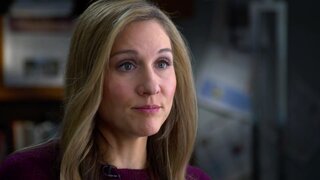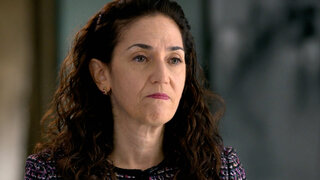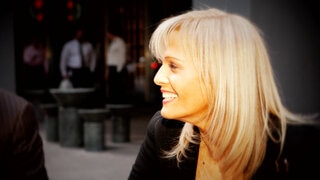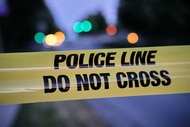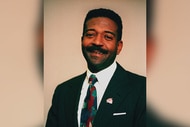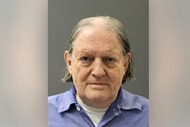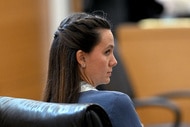Create a free profile to get unlimited access to exclusive videos, breaking news, sweepstakes, and more!
Man Murders Wife On New Year's Eve And Stages It To Look Like An Accident
Shele Danishefsky had been about to embark on a new chapter in her life when she was discovered dead in the bathroom of her Upper West Side apartment on Dec. 31, 2009.
New Year’s Eve is meant to signal new beginnings — but for Shele Danishefsky, it meant the end.
Danishefsky, a successful investment banker and mother of two, was found by her daughter face down in the bathtub of their Upper West Side apartment the morning of Dec. 31, 2009, according to “Dateline: Secrets Uncovered,” airing Wednesdays at 8/7c on Oxygen.
Her husband, Roderick Covlin, told police he pulled his wife from the tub and began performing CPR before calling 911, but it was too late. Danishefsky was dead at the age of 47.
It initially appeared to be a tragic accident. Authorities believed Danishefsky must have lost her footing and slipped in the tub, hitting her head on the way down after noticing the door of a nearby cabinet had been partially ripped off its hinges.
Her devout Orthodox Jewish family didn’t want an autopsy to be performed and Danishefsky was laid to rest — but suspicions soon began to swirl that her death hadn’t been an accident after all and her estranged husband may have carried out the devious plot to kill his wife before she could cut him out of her will.
When the couple first met, it had been love at first sight. Eve Karstaedt, Danishefsky’s sister, remembers her smitten sister calling her the night she met Covlin at a Jewish singles mixer in February 1998.
“She was all giggles and said I met a guy, a really nice guy, and she said, ‘We’re on our way to the airport to elope,’” Eve told "Dateline" correspondent Andrea Canning.
Eve was able to talk her sister out of marrying Covlin that night, but just six months later, the couple tied the knot in a lavish ceremony.
The couple welcomed their daughter, Anna, two years later.
“She was inseparable from Anna,” her brother-in-law Marc Karstaedt recalled. “She was an incredible mom.”
The couple then suffered the agonizing loss of a set of twins, who had been born prematurely, before finally welcoming their son, Myles, into the family in 2006.
But there would soon be trouble in their relationship, as Danishefky grew increasingly frustrated by what she viewed as Covlin’s violent temper and lack of ambition.
Danishefsky was a successful wealth manager, earning both prestige and financial rewards from the position, but Covlin had struggled to find success as a stock broker.
“She said, ‘He doesn’t get a job. He goes to the gym twice a day and he’s just hanging around the house,’” Eve recalled. “She was very frustrated. She said, ‘He’s — he’s driving me crazy.’”
While Covlin seemed to have no interest in getting a job, Danishefsky’s family said he was becoming consumed with playing backgammon.
The final straw, according to Eve, was when Danishefsky learned he had also been cheating on her.
The couple broke up, but Danishefsky arranged for Covlin to move into an apartment across the hall in an attempt to ease the transition for their two children.
But as the couple proceeded toward divorce, Covlin struck back, allegedly calling Danishefsky’s employer and telling them he believed she was on drugs and claiming money had been disappearing from their bank account.
“He was trying to get her to lose her job,”Danishefsky’s divorce lawyer Lance Meyer told “Dateline: Secrets Uncovered.”
The claims were ultimately dismissed after she passed a drug test, but it created havoc in her life.
Meyer said Danishefsky also opened up about other secrets in the marriage.
“He would belittle her, he would yell at her, he would call her ugly, he would make fun of her looks, so he was a demeaning person. He would go low,” Meyer said.
RELATED: What Does Pamela Smart Say Today About The Infamous Murder Of Her Husband?
The couple also battled over custody and a judge ordered Covlin to give up backgammon, something Meyer said only enraged him further.
As the heated custody battle grew, Meyer would later testify that Covlin took his children to the hospital and claimed that Danishefsky had been molesting their young son — allegations that prosecutors would later say were completely unfounded.
Then on Dec. 31, 2009, the 47-year-old was discovered dead in the bathtub by her daughter, Anna, according to The New York Daily News.
Friends and family were struck by the odd death, believing that it wasn’t like the wealth manager to take a bath, particularly after she had gotten a keratin hair straightening treatment the previous morning that would have prevented her from getting her hair wet.
NYPD Detective Carl Roadarmel was also troubled by some of the injuries on her body.
“She had bruising to her lip. She appeared to have some scratch marks and she had bruising to her right hand,” he said.
The first officers at the scene were also troubled by the fact that Covlin, who claimed he pulled his wife out of the tub to perform CPR, wasn’t wet himself.
Yet, despite the unease, her family initially opted not to have an autopsy and her cause of death was listed as undetermined by the medical examiner. As the family’s suspicions about Covlin grew, however, they requested her body be exhumed and an autopsy was performed.
The medical examiner determined the death had been a homicide after discovering that Danishefsky’s hyoid bone in her neck had been broken, indicating she was strangled to death.
It would take years for prosecutors to build their case, but Covlin was finally arrested in 2015. The sensational trial that would follow in 2019 uncovered even more shocking allegations against Covlin, including claims that he had allegedly tried to kill his own parents after they gained custody of the children.
Prosecutors argued that a broke Covlin had murdered Danishefsky in an attempt to inherit her $5 million estate, shortly after uncovering some emails indicating that she planned to remove him from her will.
One of the prosecution’s key witnesses was Debra Oles, Covlin’s much older backgammon-opponent-turned-love-interest.
“I never saw the monster that I eventually came to know until later,” Oles told Canning about her initial belief that Covlin was not involved in his wife’s death.
However, on the stand she testified that she eventually came to observe Covlin’s “mercurial temper,” which she said was on full display during heated and physical fights with his parents.
According to her testimony, as his anger with his parents grew, Covlin started dreaming up ways to kill them, including one plan to break in through a basement window, murder them, and then set their home on fire. In another plot, she said he wanted to enlist the help of his daughter to put rat poison in their food.
Although it was never included in the trial, prosecutors also found evidence that Covlin had once tried to frame his own daughter by writing an email from her account seemingly claiming responsibility for Danishefsky’s death.
“I lied. She didn’t just slip,” the note read, in part, according to “Dateline: Secrets Uncovered.” “I got so mad so I pushed her.”
The note was never sent.
Although the defense never called any witnesses to testify on Covlin’s behalf during the trial, his parents continued to support him to “Dateline: Secrets Uncovered.”
“The alleged murder plots I think are a farce,” his dad, Dave Covlin, said.
In court, defense attorney Robert Gottleib focused on what he believed was a lack of physical evidence tying Covlin to the crime and argued that the father of two should not be convicted just on the basis of his character flaws.
“You may despise him. You may not even be able to look at him. You may want to convict him. To convict somebody of murder there’s got to be proof,” he told “Dateline: Secrets Uncovered.”
It wouldn’t be enough, however, to convince a jury, and Covlin was convicted of second-degree murder for the death of his wife.
“It wasn’t a moment of celebration,” Marc said of the justice the family finally received years after Danishefsky’s death. “It was a moment of relief for fear of what would have been if the wrong verdict came down.”

